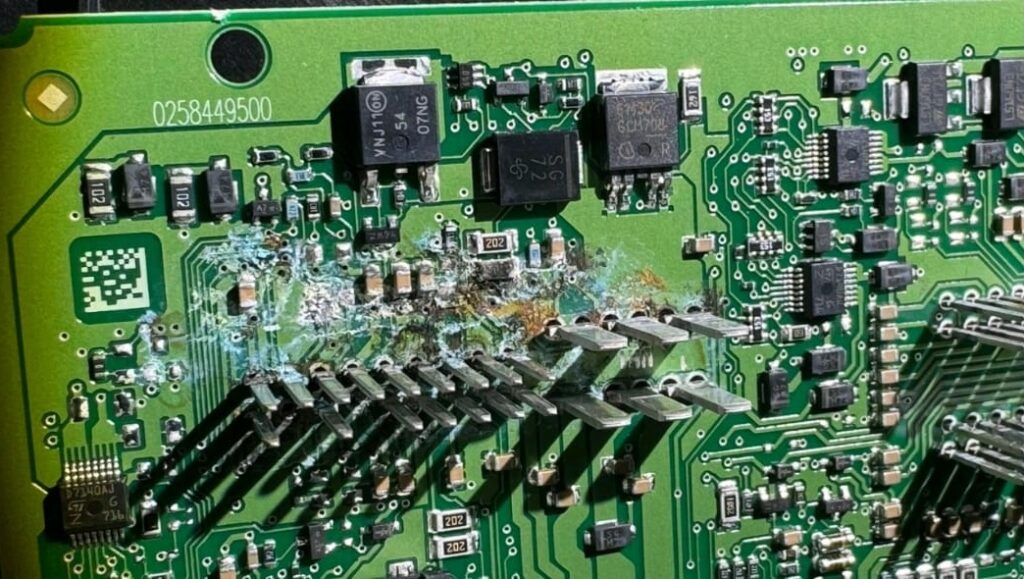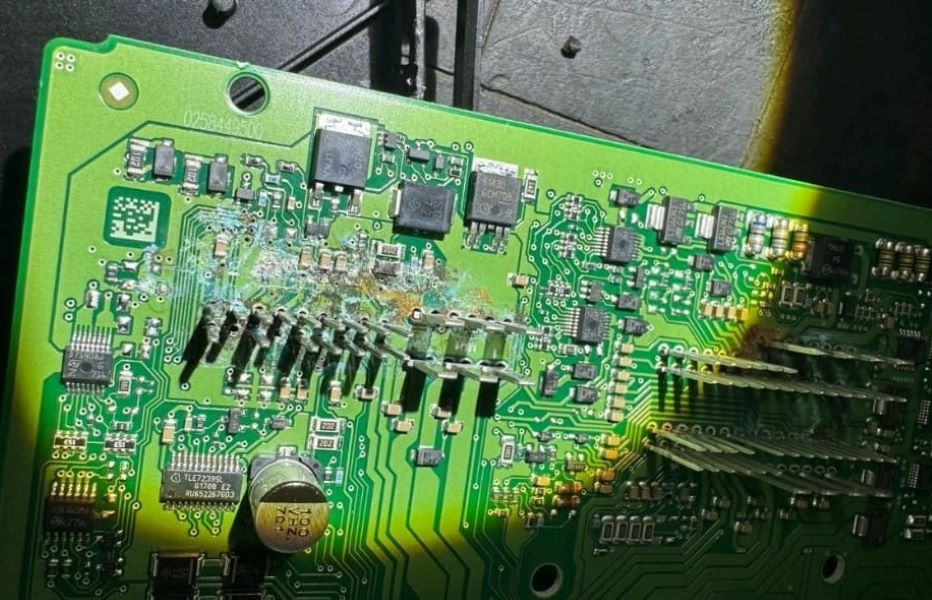Table of Contents
Mercedes Benz Not Starting: G-Class Case Study & SAM Module Diagnosis
When your Mercedes-Benz G-Class refuses to start, it can be alarming especially when there’s no sound, no crank, and no dashboard response. This guide details a real-world case study of a Mercedes G-Class (W463) with a no-start condition caused by an unresponsive SAM (Signal Acquisition Module) due to water ingress.
By following a structured diagnostic process, the issue was identified, repaired, and permanently resolved restoring the G-Class to its reliable performance.

Case Study Overview
| Vehicle | Mercedes-Benz G-Class (W463) |
|---|---|
| System Affected | SAM (Signal Acquisition and Actuation Module) |
| Complaint | Vehicle won’t start, no crank, no lights |
| Root Cause | Water ingress under center console causing SAM failure |
Step-by-Step Diagnostic Process
Step 1 : Initial Assessment
When a Mercedes-Benz won’t start, the first priority is to check the battery, ignition, and main electrical systems.
Checks performed:
- – Verified battery voltage and connection integrity.
- – Tested ignition switch and starter relay circuits.
- – Scanned all control units using Mercedes XENTRY Diagnostic Tool.
Diagnostic finding:
The SAM (Body Control Module) was completely unresponsive, a major clue since it manages all primary electrical operations, including ignition authorization and keyless start.


Step 2 : Investigating the SAM Module
The SAM module in the G-Class W463 is located under the center console, an area vulnerable to water accumulation if drains are clogged or seals are compromised.
After removing the console panels, the technician discovered visible water pooling beneath the module. This water had begun corroding connectors and shorting internal circuits.
Cause Identified:
Water ingress caused the SAM module to lose communication with the ECU and ignition system resulting in a complete electrical shutdown.



Step 3 : Drying and Repair Procedure
Actions taken:
- 1. Removed the center console and lifted the SAM module housing.
- 2. Carefully dried the area using air blowers and absorbent material.
- 3. Cleaned corroded connectors with contact cleaner and inspected for burnt pins.
- 4. Restored the wiring harness after confirming insulation integrity.
- 5. Reinstalled and reconnected the SAM module once the environment was moisture-free.
After reassembly, the vehicle was reconnected to XENTRY for a system recheck.
Result: The SAM module responded successfully, and the engine started immediately.
Understanding the SAM Module in Mercedes-Benz
The Signal Acquisition and Actuation Module (SAM) is the central electrical hub in many Mercedes models. It processes inputs from sensors and switches, then communicates commands to actuators across the CAN bus network.
Functions Controlled by the SAM:
| Category | Functions Managed |
|---|---|
| Lighting | Headlights, turn signals, interior lights |
| Comfort Systems | Windows, mirrors, central locking |
| Safety Systems | Wipers, washers, defrost, parking sensors |
| Powertrain | Start authorization, ignition, ECU communication |
In short, if the SAM fails, the vehicle won’t crank or start, even if the battery and starter are healthy.
Common SAM Module Failures
| Failure Type | Cause | Symptoms |
|---|---|---|
| Water ingress | Clogged drains, poor sealing | No start, no lights, dead electronics |
| Electrical short | Damaged wiring harness | Intermittent communication faults |
| Corrosion | Moisture exposure | Inconsistent voltage readings |
| Software corruption | Low voltage during update | Fault codes, partial module failure |
How the SAM Affects No-Start Conditions
When the SAM becomes unresponsive:
- – The ECU cannot receive ignition authorization.
- – The starter relay circuit remains open, preventing crank.
- – Even dash lights and key recognition may fail.
That’s why water damage under the console can mimic a completely dead vehicle, even if the battery and ignition are fine.
Repair & Prevention Tips
| Step | Procedure | Result |
|---|---|---|
| Drainage system check | Inspect A-pillar and sunroof drains | Prevents water pooling |
| Seal verification | Check console and firewall grommets | Stops moisture entry |
| Electrical inspection | Look for corrosion under seats & console | Detects early faults |
| SAM protection | Apply moisture-resistant sealant | Reduces future exposure |
| Battery maintenance | Maintain 12.6V+ during storage | Prevents low-voltage corruption |
Outcome of the Case
After drying, cleaning, and restoring electrical connections, the G-Class started flawlessly. No further error codes were found during the post-repair scan.
The repair emphasized the importance of proper waterproofing and periodic drain maintenance, especially for vehicles frequently exposed to rain or off-road conditions.
Related Diagnostic Resource
If your Mercedes is showing electrical warnings or struggling to start, explore our complete troubleshooting guides:
Mercedes Electrical Problems: Fix SAM, ECU & CAN Bus Faults; learn how to diagnose power loss, short circuits, and communication errors in control modules and wiring systems.
Mercedes No Start Issues: Causes, Fixes & Case Studies; a comprehensive guide covering electrical, fuel, and ECU-related no-start scenarios across multiple Mercedes models.
Together, these resources give you a complete diagnostic roadmap from electrical supply faults and ECU power interruptions to full no-start and communication-related issues.
FAQ: Mercedes Benz Not Starting
1. What causes the SAM module to fail in a Mercedes G-Class?
Water ingress and electrical shorts are the most common causes, especially when drainage or sealing is compromised.
2. How can I tell if my SAM module is bad?
You may experience total electrical failure no crank, no ignition, and no lights even with a charged battery.
3. Can the SAM module be repaired?
Yes, if corrosion is minimal. Cleaning and reprogramming can restore function, but severe cases require module replacement and coding.
4. Where is the SAM module located in the G-Class?
Under the center console, making it prone to damage from trapped moisture.
5. How can I prevent this issue?
Clean drainage channels, ensure rubber seals are intact, and periodically inspect under the center console for moisture buildup.
Author Bio
Written by Mercedes Expert
With years of hands-on experience diagnosing and repairing Mercedes-Benz systems, he brings technical depth and practical case studies to help car owners, technicians, and enthusiasts troubleshoot complex automotive issues. His work focuses on clear repair guides, OEM-level procedures, and knowledge-sharing to empower both professionals and drivers.
Last update: November 2025






Leave a Reply